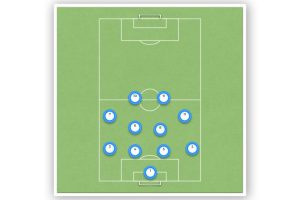10 Different Soccer Pressing Triggers
In the dynamic world of soccer, the art of pressing is integral to a team’s defensive strategy.
Pressing in soccer is not simply about applying pressure. It’s a sophisticated tactic that, when executed correctly, can drastically reduce an opponent’s time and space on the ball.
Teams that master the various pressing triggers can force their opponents into making errors, thereby regaining possession and often creating valuable opportunities to score.
Understanding when to press is as crucial as knowing how to press, and it is here that the pressing triggers become a fundamental component of a team’s defensive playbook.
Pressing triggers are pre-identified cues that signal to a team when to apply concerted pressure on the ball or an opponent.
These triggers are usually based on specific events or positions on the field that indicate an advantageous moment for the team to initiate their press.
By recognizing scenarios such as an opponent’s poor touch, a backward pass, or when the ball is played to a goalkeeper, teams can effectively disrupt their opponents’ rhythm and swing the momentum in their favor.
The execution of these pressing triggers relies not only on individual skill but also on coordinated team effort.
The types of press—high, midfield, or low—are tailored to the team’s overall tactical setup and the specific context of the game.
Key Takeaways
- Pressing effectively improves a team’s chance to regain possession and control.
- Accurate timing and coordination are required for successful pressing triggers.
- Various pressing strategies can be adapted based on the game’s tempo and opponent tactics.
Opponent’s Poor Touch
When a player on the opposing team has a bad touch, the ball often gets away from their immediate control.
This is a key moment for defenders and midfielders to apply pressure. The lack of ball control translates to an opportunity for a team to press high and force turnovers.
- Identify the Target: The player with the weak control becomes the target for pressing.
- Timing: Teammates should coordinate to press the moment a poor touch is spotted.
- Advantages: Applying pressure swiftly can cause mistakes, potentially leading to quick counterattacks.
It is important to be tactical about this pressing trigger. Players should look out for common signs of a weak player on the ball, such as hesitancy or lack of supporting teammates. In these instances, pressing effectively can lead to regaining possession.
- Trigger Signal: A visual cue, such as a hand signal or shout, can be used to initiate a well-timed press.
- Team Effort: Once pressure is applied, teammates should close down passing lanes to increase the turnover probability.
This pressing trigger requires players to be in a state of constant alertness and ready to exploit any opponent’s mistakes.
Coaches often train teams to recognize and react to these triggers, making it part of their defensive strategy. By doing so, players can turn what seems like a simple bad touch into a significant advantage for their team.
Pick A Player Trigger
In the strategy of pressing in soccer, selecting a particular player to pressure is a tactical move. This decision can be based on numerous factors.
Positional Vulnerability: Targeting a player based on their position can be effective. For example, pressing an opposing fullback can create opportunities for turnovers in dangerous areas.
Weak Foot Exploitation: Identifying and pressing a player who is compelled to use their non-dominant foot can lead to mistakes. If a right-footed center-back is playing on the left, applying pressure can cause a misstep.
Individual Weakness: A team may also opt to focus on a player who has shown a susceptibility under pressure. This might be due to lesser technical skills or a propensity to make poor decisions when hurried.
Here are actionable tactics for the “Pick A Player” trigger:
- Watch game footage to recognize which players are less comfortable with the ball.
- Prioritize pressuring players who are likely to be on their weaker foot.
- Assign players to monitor and pressure the identified opponent.
It’s crucial for the pressing team to communicate and understand who the target is, ensuring that the pressure is coordinated and effective.
The trigger is activated the moment the targeted player receives the ball, signaling the team to apply the pressing tactic. This can disrupt the flow of the opposing team and potentially lead to advantageous turnovers.
Backward Pass

A backward pass in soccer can act as a pressing trigger, often indicating a moment of vulnerability in the opposition’s play. This particular pass signifies that the opposition may be seeking to reset their play or that they’ve run out of progressive passing options.
When to apply pressure:
- Goalkeeper or defenders receive a backward pass: The team should recognize this as a cue for immediate pressure. Since these players are often less comfortable on the ball, applying pressure can force a rushed or difficult pass.
- Pass between defenders: This can isolate defenders and limit their passing options, making it ripe for initiating a press.
Pressing Traps:
Creating pressing traps involves communication and coordination among players.
Teams can funnel the ball into areas where they have numerical superiority. By cutting off passing lanes, the opposition is guided into making the backward pass, walking into a pre-set trap.
Communication:
- Players should constantly communicate to ensure they collectively identify the backward pass and synchronize their pressing actions.
- Alerting teammates to an opponent’s body language anticipating a backward pass can allow for a proactive rather than reactive press.
Key Points:
- A backward pass can signify a lack of forward options, underscoring an opportune moment to press.
- Applying pressure at this point can disrupt the opposition’s structure, increase the chance of regaining possession, and potentially create immediate goal-scoring opportunities.
Goalkeeper Possession
In soccer, when a goalkeeper controls the ball, it’s a pivotal moment that can catalyze a team to press.
A goalkeeper who may not be as adept with ball handling presents an advantageous situation. Opponents can exploit this by applying pressure to provoke an error and potentially regain control.
- Triggering the Press:
- When the goalkeeper has the ball, especially if they show signs of uncertainty or lack of skill with their feet.
Strategies for Pressuring the Goalkeeper:
- Close Down Space:
- Forwards and midfielders should immediately reduce the goalkeeper’s options for passing, forcing a rushed decision.
- Cover and Balance:
- Other players must be prepared to cover space left exposed by teammates initiating the press and should balance defensive integrity against the risk of a counter-attack.
- High-Risk High-Reward:
- Applying pressure may leave gaps in the formation; hence, players should be ready to transition back quickly if the press fails.
- Force the Direction:
- Ideally, direct the goalkeeper towards making a pass to their weaker side or close down angles to limit their options.
- Seize the Initiative:
- A successful press can lead to regaining possession high up the field, setting up potential goal-scoring opportunities.
By conscientiously pressuring the goalkeeper during their possession, a team can significantly increase its chances of sparking a profitable counter-attack. The element of surprise and taking the initiative can often unsettle even the mostcomposed goalkeepers, tipping the scales in favor of the pressing team.
Sideline Trap

When employing a Sideline Trap in soccer, the team without the ball strategically applies pressure on the opponent who is in possession near the sideline. This specific area acts almost like an additional player, reducing the space for the opponent to maneuver.
- Initiating the Trap: As soon as the ball approaches the sideline, defenders converge to limit the possibilities for the player in possession.
- Pressure Application: The pressing team works in unison to guide the opponent towards the touchline.
- Cover: Defensive players should be positioned to intercept potential passes, effectively “closing the net” on the trapped player.
The Sideline Trap is most effective when the opponent is facing their own goal, as it further reduces their viable options. To execute this successfully:
- One player rushes toward the ball carrier, ushering them toward the sideline.
- A second player positions themselves to intercept forward passes, forcing the ball carrier to either pass backward or attempt to break through the pressure.
- Teammates close passing lanes and prepare for a potential turnover.
It is essential to coordinate the trap so that once the ball is channeled along the sideline, the opponent feels the squeeze from the defensive pressure, ideally resulting in a regained possession or a forced error.
Central Passes

When a team is focused on controlling the center of the pitch, central passes can become a focal point for setting pressing traps.
By directing play to the middle, they can shrink the available space and pressure the ball-carrier, increasing the likelihood of forcing a turnover.
Central passes are predictable when the opposition is funneled into the congested middle area, making these moments ideal for initiating a press.
To effectively intercept or disrupt central passes, players need to be keenly aware of the opposing team’s passing lanes.
Cutting off these lanes requires communication between teammates to ensure they move as a unit and maintain a structure that the opponent finds difficult to bypass.
- Key Actions for Pressing on Central Passes:
- Anticipate: Players should be ready to predict where the next pass will go.
- Close Down: As soon as the pass is made, nearby players should apply immediate pressure.
- Control: Defenders need to shepherd the play towards high-pressure zones.
- Cut Off: Intercept potential passes by positioning to block passing lanes.
High Ball Transitions
In soccer, high ball transitions are critical moments where teams switch from defense to attack or vice versa.
As the ball hangs, mid-air after a clearance or a long ball, it provides a strategic moment for midfielders and forwards to prepare for a counter-press or counter-attack.
- Aerial Duels: A key aspect of high ball transitions is the battle for control during aerial duels.
- Players must leverage this time to position themselves advantageously, aiming to regain possession swiftly.
- Regaining Control: Success in these moments can shift the momentum of the game.
- If the ball drops favorably and is secured by the team, it can instantly turn a defensive posture into an offensive thrust.
The role of players during these transitions can’t be overstated:
- Midfielders are often tasked with reading the trajectory of the ball and closing down space.
- This ensures that if possession is regained, the team can pivot into a swift attack.
- Forwards, on the other hand, look to exploit any uncertainty in the opposition’s defense.
- They aim to pressure them into mistakes or position themselves for a potential flick-on or second ball.
Using high ball transitions effectively requires precise timing and anticipation from the players involved.
This strategic pressure, when applied correctly, forces the opponent into difficult positions, potentially leading to turnovers that can be capitalized upon for goal-scoring opportunities.
Defensive Throw Ins
In soccer, there’s a strategic importance to defensive throw-ins, as they present an opportunity for a team to regain control and set up their formation.
- Team Pressing: When a team is on the defense and they have a throw-in within their third of the pitch, it is vital they use this chance to organize and implement a pressing strategy. Pressing effectively can cause the opposing team to make errors, leading to turnovers. By locking onto opponents, teams increase the likelihood of regaining the ball.
- Strategy: A well-executed defensive throw-in requires detailed planning. The positioning of players should be such that it closes down space for the opponents while creating options for the thrower. Anticipating the opponents’ next move is essential.
- Communication: Clear and concise communication among teammates is critical during a defensive throw-in. They must inform each other of their positions and potential threats, ensuring that every player is aware of their role.
When a team’s throw-in occurs in a defensive context, they must perform with precision to obstruct opposing runs and maintain their structure.
Effective use of defensive throw-ins can serve as a launching point for counter-attacks, making them a potent weapon in a team’s strategy to shift from defense to offense.
Numerical Superiority
In soccer, numerical superiority is a key concept employed by teams looking to efficiently regain possession of the ball.
Achieving numerical superiority means having more players than the opponent in a given area. This often requires disciplined teamwork and a well-organized formation.
To establish numerical superiority, teams may shift their formation dynamically.
This often involves midfielders pressing up and wingers tucking in, thus creating pressing traps to outnumber the opposition.
These tactical maneuvers depend heavily on accurate tactical positioning.
Maintaining a balance is crucial, however, as overcommitting players forward might leave a team vulnerable at the back.
Adequate cover is necessary to ensure that the defensive integrity of the team remains intact.
Pressing traps set up through numerical superiority don’t just happen randomly; they are a deliberate product of a coach’s strategy and player intelligence on the field. Here’s a basic structure teams might follow:
- Midfield Pressing: By pushing one or two midfielders forward when the ball is in the opponent’s half, teams can create a localized advantage.
- Side-Line Press: Using the side-line as an additional defender, teams can corner an opponent, effectively reducing the pitch size and creating numerical superiority.
- Cover and Balance: While some players press, others must adjust to cover spaces and maintain the team’s structural balance.
Opponent Looking Down
When a player in possession of the ball glances downwards to better control it, this action can be viewed as a pressing trigger.
This is because in that moment, their awareness of the field and nearby opponents diminishes, creating a moment of weakness.
Identifying the Trigger:
- Visual Cue: Opponent’s head drops to check the ball’s position.
- Opportunity: Decreased situational awareness from the opponent.
Applying Pressure:
- Quick Response: Defenders should use this cue to immediately close down on the ball carrier.
- Team Effort: Surrounding players ought to tighten space, cutting off passing lanes.
Pressing Tactics:
- Approach from the player’s blind side to limit their options when they look up.
- Force the player towards areas with higher teammate presence.
- Communicate with teammates to ensure coverage as pressure is applied.
By capitalizing on the moment an opponent looks down, a team can effectively apply pressure and potentially regain possession, turning a simple action into a strategic advantage on the pitch.
Switch of Play

In soccer, a switch of play occurs when the ball rapidly moves from one side of the field to the other.
This strategic move exploits the open space and can shift the defensive team’s balance, creating opportunities for the attacking team to take the initiative.
- Spotting the Trigger:
- As the ball travels to the far side (often called the weak side), defenses may become unsettled, providing a prime moment for the attacking team to apply pressure.
- Players must be vigilant and coordinate their movements to effectively execute a press during this transition.
- Countering the Press: Teams may employ a counter-press to reclaim the ball once it has been switched.
- The idea is to press intensely right after losing possession, aiming to prevent the opponent from establishing control.
- Quick, organized pressure can deter the opposition from exploiting the newly found space.
- Tactical Considerations:
- Zonal Press: Players cover specific areas, allowing them to respond swiftly to the ball’s movement across the pitch.
- Man Marking: Alternately, closely following designated opponents can disrupt their ability to receive and settle the ball after a switch of play.
- Execution: Conducted correctly, pressing during a switch of play forces the opponent into hasty decisions, potentially leading to turnovers and an immediate offensive opportunity.
- Overall Strategy:
- Teams should train to recognize these moments and have a clear plan to act, ensuring that when they execute the press, they do so with communal effort and synergy.
Frequently Asked Questions
This section addresses common inquiries related to soccer pressing strategies, providing insights on various pressing tactics in different formations and scenarios.
How does the gegenpressing strategy work in modern soccer?
Gegenpressing, or counter-pressing, is a tactic where a team immediately attempts to regain possession after losing the ball.
The idea is to recover the ball near the opponent’s goal to launch a quick attack.
Can you explain the pressing technique used in football (soccer)?
Pressing in soccer is a defensive strategy aimed at exerting pressure on the ball carrier and potential passing options.
This technique seeks to force errors or win possession by reducing time and space for the opponent.
What are the key strategies for pressing in a 4-3-3 formation?
In a 4-3-3 formation, pressing strategies typically involve the front three forwards initiating pressure on the back line. Meanwhile, the midfielders cover passing lanes. Effective communication and positional awareness are vital to maintain team shape during the press.
What’s the best approach to overcome a 4-4-2 press in soccer?
To break a 4-4-2 press, teams often utilize quick passes to bypass the first line of pressure. They may also leverage wide areas where there may be more space to operate. Maintaining possession and making calculated movements can help mitigate the press’s effectiveness.
How do pressing traps differ when applied inside vs. outside the pitch?
Pressing traps are strategically planned areas where a team forces play to regain possession.
Inside the pitch, traps are set to narrow the play and limit the opponent’s options. On the outside, teams use the touchline as an extra defender to box in the opposition.








